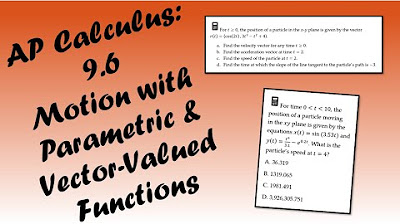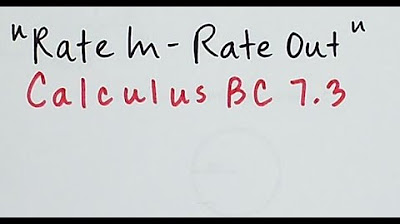Parametric Free Response Questions
TLDRThis video tutorial focuses on tackling free response questions for AP Calculus involving parametric equations. It revisits the fundamental theorem of calculus to recover positions from velocity equations and initial positions. The instructor demonstrates how to find positions, calculate the length of a vector, determine speed and total distance traveled, and solve for specific instances using integrals and derivatives. The video also covers the concept of average speed and introduces a potential new question type regarding the acceleration or deceleration of a particle's speed in a parametric scenario, providing step-by-step solutions and insights for students preparing for the AP exam.
Takeaways
- 📚 This video discusses AP Calculus free response questions involving parametric equations.
- 🔄 It emphasizes the use of the Fundamental Theorem of Calculus to find positions given velocity equations and initial positions.
- 📝 The process of finding x of 1 involves integrating the given velocity function and adding the initial position.
- 📊 To find the y-coordinate, the same integration process is applied using the y-velocity function.
- 📐 The Pythagorean theorem is used to find the length or absolute value of a vector, which is essential for calculating speed.
- 🚀 The speed of an object with a parametric velocity vector is found by taking the square root of the sum of the squares of the x and y velocity components.
- 🧩 Integrating the absolute value of velocity over a time interval gives the total distance traveled, which is equivalent to the arc length.
- 📈 Practical examples from past AP exams illustrate the application of these concepts, including using a calculator for complex integrations.
- 🔄 The video also covers solving for specific values such as when the slope of the path equals a certain value or when the speed is a specific number.
- 🛠️ Additional topics include calculating average speed and determining if an object is speeding up or slowing down based on the derivative of speed.
Q & A
What is the fundamental theorem of calculus restated in the context of parametric equations?
-The fundamental theorem of calculus can be restated for parametric equations as: \( f(b) = f(a) + \int_{a}^{b} f'(x) \, dx \). This is used to recover positions given a velocity equation or equations and an initial position.
How is the position at a certain time in a parametric equation determined?
-The position at a certain time, say \( x(1) \), can be determined by using the initial position \( x(0) \) and integrating the velocity function \( x'(t) \) from 0 to 1: \( x(1) = x(0) + \int_{0}^{1} x'(t) \, dt \).
What is the integral used to find the x-coordinate of position in the given example?
-The integral used to find the x-coordinate of position is \( \int_{0}^{1} \sqrt{t + 1} \, dt \), which represents the area under the curve of the velocity function from 0 to 1.
What is the antiderivative of \( \sqrt{t + 1} \)?
-The antiderivative of \( \sqrt{t + 1} \) is \( \frac{2}{3}(t + 1)^{\frac{3}{2}} \).
How do you find the y-coordinate of position using the same setup as the x-coordinate?
-You find the y-coordinate of position by setting up the integral \( \int_{0}^{1} y'(t) \, dt \) and solving it, where \( y'(t) \) is the derivative of the y-position function with respect to time.
What is the formula for finding the length of a two-dimensional vector?
-The length of a two-dimensional vector \( (a, b) \) is found using the Pythagorean theorem: \( \sqrt{a^2 + b^2} \).
How is the speed of an object moving along a parametric curve calculated?
-The speed of an object is the magnitude of its velocity vector, calculated as \( \sqrt{x'(t)^2 + y'(t)^2} \).
What is the formula for the total distance traveled by an object moving along a parametrically defined curve?
-The total distance traveled is the integral of the speed with respect to time: \( \int_{t_1}^{t_2} \sqrt{x'(t)^2 + y'(t)^2} \, dt \).
How do you find the time when the slope of the object's path is 1.01 in the given example?
-You set up the equation \( \frac{y'(t)}{x'(t)} = 1.01 \) and solve for \( t \) using a calculator, finding the time when the slope condition is met.
What is the expression used to determine if the speed of an object is increasing or decreasing?
-The derivative of the speed with respect to time is taken, and if the result is negative, the speed is decreasing; if positive, the speed is increasing.
How is the average speed calculated in the context of parametric equations?
-The average speed is calculated by integrating the speed function over the interval and dividing by the width of the interval: \( \frac{1}{b-a} \int_{a}^{b} \sqrt{x'(t)^2 + y'(t)^2} \, dt \).
Outlines
📚 Introduction to Parametric Equations in AP Calculus
The video begins with an introduction to free response questions related to parametric equations in AP Calculus. The presenter recalls the fundamental theorem of calculus, which is used to find positions given velocity equations and an initial position. The method involves integrating the velocity function from an initial time to a final time and adding the initial position. The example provided uses a velocity function where the derivative of position with respect to time is the square root of t plus 1. The presenter demonstrates how to find the x-coordinate of the position at a specific time by integrating this function and using the given initial condition.
🔍 Calculating Position and Speed Using Parametric Equations
The second paragraph delves deeper into the process of calculating the position of an object at a given time using parametric equations. The presenter guides the audience through finding the y-coordinate of the position at time t equals 1, using the same integration technique as before. The video then introduces the concept of finding the length of a two-dimensional vector using the Pythagorean theorem, which is essential for understanding the magnitude of velocity vectors. The presenter also explains how to calculate the speed of an object by taking the absolute value of the velocity vector and how to find the total distance traveled by integrating the speed over a given interval.
📉 Solving AP Calculus Free Response Problems with Parametric Equations
In this section, the presenter tackles specific free response problems from past AP Calculus exams, using the concepts discussed earlier. The first example is based on a 2015 BC question, where the presenter corrects a previous mistake and proceeds to find the position of an object at a specific time by integrating the given parametric equations. The presenter also solves for the time when the slope of the object's path is 1.01 and when the speed of the object equals 1.3. The process involves setting up the equations, using a calculator for integration, and interpreting the results to answer the questions.
🚀 Advanced Concepts: Speed, Acceleration, and Distance in Parametric Motion
The final paragraph covers more advanced concepts such as finding the speed of a particle at a specific time, calculating the acceleration vector, and determining the total distance traveled by an object following a parametric path. The presenter uses a 2011 BC question as an example to illustrate these calculations. Additionally, the presenter introduces the concept of average speed and shows how it relates to the total distance traveled over the total time. The video concludes with a hypothetical question about determining whether an object is speeding up or slowing down by analyzing the derivative of the speed function with respect to time.
Mindmap
Keywords
💡Free Response Questions
💡Parametric Equations
💡Fundamental Theorem of Calculus
💡Velocity
💡Antiderivatives
💡Arc Length
💡Speed
💡Absolute Value
💡Integration
💡Differentiation
💡Average Speed
💡Acceleration
💡Dot Product
Highlights
Introduction to free response questions for AP Calculus focusing on parametric equations.
Recalling the fundamental theorem of calculus to recover positions given velocity equations and initial positions.
Using the integral to find the x-coordinate of position given the initial position and velocity equation.
Integration of the velocity equation to find the x-coordinate at a specific time.
Finding the y-coordinate of position using a similar method to the x-coordinate.
Explanation of the Pythagorean theorem in the context of finding the length of a vector.
Calculating the absolute value of a vector to determine speed in AP Calculus.
Deriving the formula for the total distance traveled by an object using the absolute value of velocity.
Solving a problem from the 2015 BC exam using the integral of velocity to find the position at a specific time.
Using a calculator to find when the slope of the object's path is equal to a specific value.
Determining when the speed of the object equals a given value using the velocity vector.
Calculating the total distance traveled by integrating the speed function.
Working through a problem from the 2011 BC exam to find the speed of a particle at a specific time.
Using derivatives to find the acceleration vector of a particle.
Exploring the concept of average speed and its calculation in the context of parametric equations.
Discussing the potential for a question on speeding up or slowing down in a parametric equation scenario.
Using the derivative of speed to determine if the object is speeding up or slowing down.
Encouraging practice with recent parametric free response problems to familiarize with common patterns and techniques.
Transcripts
Browse More Related Video

AP Calculus BC Lesson 9.6

Rate In - Rate Out

Polar, Parametric, Vector Multiple Choice Practice for Calc BC (Part 2)

2023 AP Calculus BC Free Response Question #2

Polar, Parametric, Vector Multiple Choice Practice for Calc BC (Part 3)

2011 Calculus BC free response #1a | AP Calculus BC solved exams | AP Calculus BC | Khan Academy
5.0 / 5 (0 votes)
Thanks for rating: